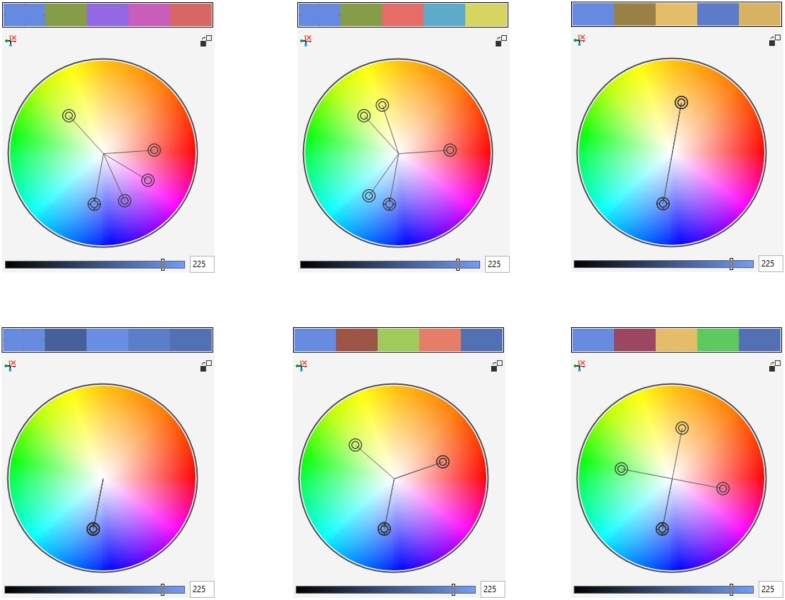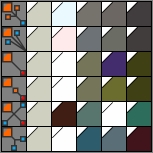Edit color styles
You can edit an individual color style or a color style in a harmony.
When you edit a harmony, you can edit color styles simultaneously by preserving the relationship between them, or you can modify individual color styles within the harmony.
When you change the hue of the master color style in a gradient, all its derivative shades are updated based on the new hue and the original saturation and brightness value.
Harmony rules
You can apply a rule to a color harmony to shift all colors according to predetermined logic and create various color schemes (combinations). The selected color in the color harmony is considered to be the base color and is used as reference to position the remaining colors on the color wheel.
You can also use a harmony rule to create a color harmony from scratch. The resulting color harmony contains five colors that are created randomly based on the chosen rule, and its base color is the selected color in the harmony swatch list.
The following harmony rules are available.
•
Analogous — includes colors that are next to each other on the color wheel, creating clear and smooth color schemes
•
Analogous - Accented — similar to the Analogous rule, but includes a complementary (contrasting) color in addition to the adjacent colors
•
Complementary (also known as "contrast") — balances the base color with the opposite color on the color wheel. Warm and cold colors are created for vibrant and energetic color schemes.
•
Monochromatic — includes variations of a single color, creating soothing color schemes
•
Tetrad — based on a pair of colors and their complements on the color wheel. This rule usually creates bold color harmonies and requires careful planning when used.
•
Triad — balances the base color with colors that are situated close to the opposite end of the color wheel, forming a triangle. This harmony rule usually creates color schemes of soft contrast.
Examples of color harmonies created from scratch by using the following harmony rules: (top) Analogous - Accented, Analogous, Complimentary; (bottom) Monochromatic, Triad, Tetrad
The icons on the harmony folders show that the color harmonies are based on different harmony rules. From top to bottom: Analogous - Accented, Analogous, Complementary, Monochromatic, Tetrad, and Triad.
Editing color harmonies
You can edit color harmonies in various ways: by removing a previously applied harmony rule, by substituting the base color with the opposite color on the color wheel, by moving colors to different arms on the color wheel, and by dragging the color harmony on the color wheel.
You can select colors from multiple color harmonies and edit them simultaneously. This feature lets you edit multiple rule-based color harmonies at the same time without removing the rules.
In addition, you can convert a color style to the Grayscale color mode from within the Color Styles docker.
To edit a color style

1
Click
Window  Color Styles
Color Styles.
2
In the
Color Styles docker, select an individual color style or a color style in a harmony.
3
In the
Color editor or
Harmony editor, edit the color style by using any of the available controls:
Eyedropper tool, color viewers, sliders, and palettes.
For more information about choosing colors, see
Color.
|
|
|
|
|
Select the color style in the Color Styles docker, and type a new name in the name box at the top of the docker. |
Convert a color style to a different color mode |
Click the Convert button  , and choose a color mode from the flyout. |
Convert a color style to a spot color |
Click the Convert button  , and choose Convert to Spot. |
To edit a color harmony

1
Click
Window  Color Styles
Color Styles.
2
In the
Color Styles docker, click a harmony folder.
3
Do any of the following:
•
In the
Harmony editor, click a selector ring and drag to edit the color styles in the harmony. To constrain the movement of the selector ring, hold down while dragging the selector ring to preserve the original saturation, or hold down
Shift to preserve the original hue.
•
In the
Color editor, choose a color by using any of the available controls: Eyedropper tool, color viewers, sliders, and palettes. For more information about choosing colors, see
Color.
4
In the
Harmony editor, move the
Brightness slider to change the tint of the color.
If you want to specify the exact tint, type a value in the
Brightness box.

To edit an individual color style in the harmony, select the style by clicking its swatch in the harmony folder, or by clicking its respective selector ring or swatch in the Harmony editor.
You can resize the Color harmonies area so that you can view available color harmonies without scrolling by pointing to the grab area, and when the cursor changes to a two-directional arrow, dragging the edge of the pane.
You can reorder color harmonies by dragging a color swatch.
To apply a rule to a color harmony

1
Click
Window  Color Styles
Color Styles.
2
In the
Color Styles docker, click a harmony folder.
3
Choose a rule from the
Harmony rule list box.
|
|
|
Create a rule-based color harmony from scratch |
Make sure that no color styles are selected, and choose a rule from the Harmony rule list box. |
Distribute colors evenly when changing a harmony rule |
Make sure the Distribute colors button  is enabled, and choose a harmony rule from the Harmony rule list box. Colors will be distributed evenly along the arms on the color wheel, which can result in radical color changes. When the Distribute colors button is disabled, color relationships in the color harmony are maintained. |

You can choose Custom from the Harmony rule list box to remove a previously applied rule or start a new harmony folder.
To edit a color harmony

1
Click
Window  Color Styles
Color Styles.
2
In the
Color Styles docker, click a color style in a color harmony.
3
In the Harmony editor, perform any of the following tasks.
|
|
|
Remove a rule from a color harmony |
Click the Remove harmony rule button  . |
Change to the opposite color on the color wheel |
Click the Switch to opposite color button  . |
Move a color to another arm |
Holding down Alt, drag a selector ring to another arm. This feature is available for color harmonies that are based on the Complementary, Tetrad, or Triad harmony rule as well as custom color harmonies. |
Edit multiple color harmonies simultaneously |
Click the color styles you want while holding down Ctrl, and drag a selector ring in the Harmony editor. |
Convert a color style to the Grayscale color mode |
Click the Convert button  , and click Convert to grayscale. |

You can also convert a color style or a color harmony to the Grayscale color mode in the Create Color Styles docker when you are creating a color style or a color harmony from a selected object. For information about how to access the Create Color Styles docker, see To create a color style or harmony from a selected object.

